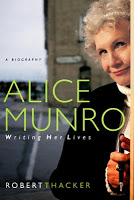Alice Munro, one of our national literary treasures, has been awarded the ultimate international literary prize, The Nobel Prize in Literature. Way to go Alice!
Beyond reading her wonderful fiction, you may wish to also find out more about her life.
Where did she grow up, how did she develop as a writer, who were her influences, what was the impact on her family, etc….
Listed below are books about Alice Munro’s life and her impact and influence on the literary scene, both at home and abroad.
Alice Munro: writing her lives: a biography (M) also: ebook
by Robert Thacker
By following “the parallel tracks” of Alice Munro’s life and Alice Munro’s texts, he gives a thorough and revealing account of both her life and work. “There is always a starting point in reality,” she once said of her stories, and this book reveals just how often her stories spring from her life. The book is chronological, starting with her pioneer ancestors, but with special attention paid to her parents and to her early days growing up poor in Wingham. Then all of her life stages — the marriage to Jim Munro, the move to Vancouver, then to Victoria to start the bookstore, the three daughters, the divorce, the return to Huron County, and the new life with Gerry Fremlin — leading to the triumphs as, story by story, book by book, she gains fame around the world, until rumours of a Nobel Prize circulate . . .
Lives of Mothers and Daughters: growing up with Alice Munro (M)
by Sheila Munro
Mothers and Other Clowns : the stories of Alice Munro (M)
by Magdalene Redekop
“This study of the work of Alice Munro focuses on her obsession with mothering, relating it to the hallucinatory quality of her magic realism. A bizarre collection of clowning mothers parade across the pages of Munro’s fiction, playing practical jokes, performing stunts, and dressing in thrift shop disguises that recycle vintage literary images. Paying close attention to their mimicries, Magdalene Redekop studies this parade with the aim of gaining increased understanding of Munro’s evolving comic vision. As the outlines of her aesthetic are delineated, it becomes clear that it involves a new way of looking at autobiography and a new way of looking at narrative sequence. This book should be of interest to undergraduates and academics of literature, particularly Canadian literature and women’s studies.” – publisher
The Rest of the Story: critical essays on Alice Munro (M)
edited by Robert Thacker

